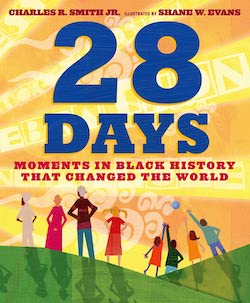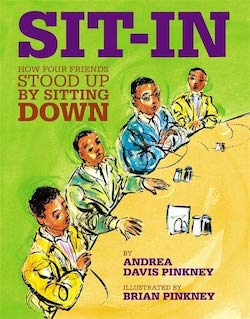Book Reviews: Black Activism in a Quartet of Children’s Books
By Cyrisse Jaffee
Given the increasing backlash against books that promote equity and diversity, and the fact that many schools still spotlight Black history in February, here is a sampling of the many excellent Black history and biography books for children published in the past few years.
Charles R. Smith Jr, 28 Days: Moments in Black History That Changed the World. Illustrated by Shane W. Evans. Roaring Brook Press, 2015.
Susan E. Goodman, The First Step: How One Girl Put Segregation on Trial. Illustrated by E.B. Lewis. Bloomsbury, 2016.
Andrea Davis Pinkney, Sit-In: How Four Friends Stood Up by Sitting Down. Illustrated by Brian Pinkney. Little, Brown & Co, 2010.
Nikole Hannah-Jones and Renée Watson. Born on the Water. Illustrated by Nikkolas Smith. Penguin, Random House, 2021.
 As Charles R. Smith Jr. says, in his book, 28 Days: Moments in Black History That Changed the World: “I’ve always had a love-hate relationship with Black History Month. I love that Black culture is shared and studied for a whole month, but as a student of color, I hated the idea of ignoring it the other eleven months. On top of that, I kept learning the same things about the same people and after a while, no matter how proud I was of my culture, I got bored and just stopped listening.”
As Charles R. Smith Jr. says, in his book, 28 Days: Moments in Black History That Changed the World: “I’ve always had a love-hate relationship with Black History Month. I love that Black culture is shared and studied for a whole month, but as a student of color, I hated the idea of ignoring it the other eleven months. On top of that, I kept learning the same things about the same people and after a while, no matter how proud I was of my culture, I got bored and just stopped listening.”
So, yes, “Black History Month” is problematic for all kinds of reasons. But given the increasing backlash against books that promote equity and diversity, and the fact that many schools still spotlight Black history in February, here is just a sampling of the many excellent Black history and biography books for children published in the past few years.
Hopefully, the people that Smith Jr chose in 2015 for 28 Days are now better known to more kids, but it’s still a useful compendium. Arranged chronologically, each spread uses striking art and design to dramatize men, women, events, and documents that have shaped Black history — from patriot Crispus Attucks’s death by a British soldier on March 5, 1770, to the inauguration of Barack Obama on January 29, 2009. Some are presented with little or no commentary (e.g., the 14th Amendment on July 9, 1868). Others are told through rhyme, essay, eulogy, or annotation. The result is engaging and enlightening. You’ll recognize many of the names: Harriet Tubman, Jesse Owens, Jackie Robinson, Malcolm X, and others. (It’s unfortunate that Rosa Parks gets the “tired-seamstress-who-sat” trope, when the truth is that she was already a civil rights activist whose actions were deliberate.) However, other folks may be less familiar: cardiologist Daniel Hale Williams, soldier Henry Johnson, entrepreneur Madame C.J. Walker, and aviator Bessie Coleman. On the 29th day, the text entreats the reader: “What will today bring/what will today be,/ will today be the day you make history?”
 Sarah Roberts is another name children should know, especially in the Boston area. The First Step: How One Girl Put Segregation on Trial by Susan E. Goodman, tells her story. Sarah was four years old when she was told she could no longer attend the all-white Otis School in Boston. She came from a long line of freedom fighters — her great-grandfather had fought in the Revolutionary War — and her parents decided it was time to challenge the segregation laws in Massachusetts. Hiring Black lawyer Robert Norris to argue their case, they were also aided by white lawmaker, abolitionist, and later senator Charles Sumner.
Sarah Roberts is another name children should know, especially in the Boston area. The First Step: How One Girl Put Segregation on Trial by Susan E. Goodman, tells her story. Sarah was four years old when she was told she could no longer attend the all-white Otis School in Boston. She came from a long line of freedom fighters — her great-grandfather had fought in the Revolutionary War — and her parents decided it was time to challenge the segregation laws in Massachusetts. Hiring Black lawyer Robert Norris to argue their case, they were also aided by white lawmaker, abolitionist, and later senator Charles Sumner.
Although she and her family lost their suit in 1847, people rallied and continued to fight. In 1855, Boston schools were officially integrated. Told in dramatic prose, and richly illustrated by the award-winning E.B. Lewis, the book shows that “The march toward justice is a long, twisting journey.” In the book, that journey leads up to the 1954 Brown v. Board of Education decision, which eliminated the “separate but equal” doctrine that had so long discriminated against students of color. Since the complicated history of segregation and integration is ongoing, it’s a good choice to start a conversation about these issues. A timeline, biographical notes, and other resources are provided by the author.
 Another rousing story of civil right activism comes from author and publisher Andrea Davis Pinkney, illustrated by her husband Brian Pinkney, known for their collaborations on many books about Black history and culture: Sit-In: How Four Friends Stood Up By Sitting Down. Inspired by Martin Luther King Jr. and his messages about love (“We must meet hate with love” and “Be loving enough to absorb evil”), four young Black men in Greensboro, North Carolina, chose to sit at the “whites only” Woolworth’s lunch counter in 1960. They had a simple order: a doughnut with coffee, with cream on the side. But their actions were far from simple. They were attacked, physically and verbally, by those who did not want Black people to enjoy the same rights as white people. And despite the risks, more students joined in, and their peaceful resistance inspired lunch counter protests throughout the south. These and other efforts to desegregate public places, including libraries, swimming pools, buses, and parks, mobilized young people to get involved in the fight. Led By Ella Baker, they formed the Student Nonviolent Coordinating Committee (SNCC), which continued to mobilize and empower young people. The book features energetic, impressionistic illustrations, splashed with color, and a narrative that easily takes the reader along the series of events that helped propel the civil rights movement.
Another rousing story of civil right activism comes from author and publisher Andrea Davis Pinkney, illustrated by her husband Brian Pinkney, known for their collaborations on many books about Black history and culture: Sit-In: How Four Friends Stood Up By Sitting Down. Inspired by Martin Luther King Jr. and his messages about love (“We must meet hate with love” and “Be loving enough to absorb evil”), four young Black men in Greensboro, North Carolina, chose to sit at the “whites only” Woolworth’s lunch counter in 1960. They had a simple order: a doughnut with coffee, with cream on the side. But their actions were far from simple. They were attacked, physically and verbally, by those who did not want Black people to enjoy the same rights as white people. And despite the risks, more students joined in, and their peaceful resistance inspired lunch counter protests throughout the south. These and other efforts to desegregate public places, including libraries, swimming pools, buses, and parks, mobilized young people to get involved in the fight. Led By Ella Baker, they formed the Student Nonviolent Coordinating Committee (SNCC), which continued to mobilize and empower young people. The book features energetic, impressionistic illustrations, splashed with color, and a narrative that easily takes the reader along the series of events that helped propel the civil rights movement.
A more somber note, appropriately, is offered in Born on the Water by Nikole Hannah-Jones and Renée Watson, part of the 1619 Project. The authors explain, “We hope all young people who read this book are inspired to ask questions about where they’re from and to learn their own origin stories. We especially hope Black American children who may be longing to feel connected to their roots come away empowered by the knowledge that there is no shame in descending from American slavery, and with the understanding that they come from a resilient people who loved, resisted, and persevered.”
 When a little girl asks her grandmother about where she comes from, she is told “our story does not begin with whips and chains,” but with life in the Kingdom of Ndongo in West Central Africa — a sophisticated civilization, where people farmed, traded, raised children, and so on. But “ours is no immigration story,” Grandma says. Kidnapped and forced into “the bottom of an evil ship,” they were brought to a new world that “they had no desire to see.” The horrors of the slave trade are told in stark detail, as are the brutalities of life as an enslaved person. But throughout, there is underlying triumph in survival, love, and family in the face of oppression. Illustrated in dark blues and browns, the poetry of the text shines through: “And that is why the people say. We were born on the water. We come from the people who refused to die.”
When a little girl asks her grandmother about where she comes from, she is told “our story does not begin with whips and chains,” but with life in the Kingdom of Ndongo in West Central Africa — a sophisticated civilization, where people farmed, traded, raised children, and so on. But “ours is no immigration story,” Grandma says. Kidnapped and forced into “the bottom of an evil ship,” they were brought to a new world that “they had no desire to see.” The horrors of the slave trade are told in stark detail, as are the brutalities of life as an enslaved person. But throughout, there is underlying triumph in survival, love, and family in the face of oppression. Illustrated in dark blues and browns, the poetry of the text shines through: “And that is why the people say. We were born on the water. We come from the people who refused to die.”
It’s an inspiring story, unique and powerful, yet resonating with all those whose ancestors fought back, resisted, and believed in a better future ahead. Grandma explains, “That is why we say Black Lives Matter, why we celebrate Black Girl Magic.… Never forget you come from a people of great strength.” Like other aspects of the 1619 Project, this book likely to raise the ire of those who prefer to whitewash — pun intended — American history. For the rest of us, it’s a lesson that should be learned and never forgotten.
Cyrisse Jaffee is a former children’s and YA librarian, a children’s book editor and book reviewer, and a creator of educational materials for WGBH. She holds a master’s degree in Library Science from Simmons College and lives in Newton, MA.
